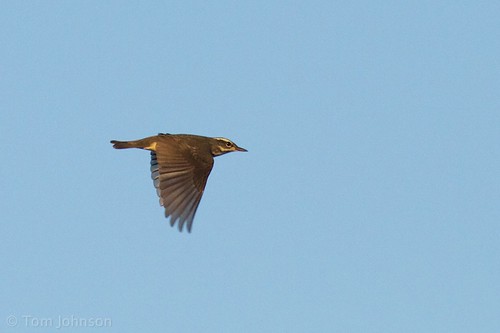CMBO
is pleased to provide weekly summaries of the Cape's birding
highlights. Coverage is limited to sightings in Cape May County. Readers
should keep in mind that some reports may not be confirmed. The vast
majority of information utilized in these reports comes from eBird data
and "Keekeekerr" text alerts. Observers are encouraged to send reports and photos to
compiler Tom Reed (coturnicops at gmail dot com).
Location Abbreviations/Explanations: CMP (town of Cape May Point); CMPSP (Cape May Pt. State Park); HB (Higbee Beach Wildlife Management Area); Higbee Dike (dredge spoils at northwest corner of Cape Island, site of CMBO's Morning Flight count); SCMM (South Cape May Meadows); SHPt (Stone Harbor Point).
--===============--
WATERFOWL THROUGH RAPTORS
The season's first Northern Shoveler arrived at SCMM 23 Aug (m. ob.), with 4 birds there by 28 Aug (m. ob.). A strong total of 36 Wild Turkeys was notched along New England Road near HB 29 Aug (Jacob Cuomo). A southbound Common Loon was seen from Avalon during strong easterly winds 24 Aug (MG, DLP, TR). A boat trip to the Gull Island area found ca. 2,500 Double-crested Cormorants, 375 Great Egrets, 800 Snowy Egrets, 15 Little Blue Herons, 30 Tricolored Herons, and 25 Black-crowned Night-Herons 24 Aug (m. ob.). An evening survey of the same area produced 302 Great Egrets, 891 Snowy Egrets, 27 Little Blue Herons, and 38 Tricolored Herons 27 Aug (TJ, SWi, TR). Raptor migration was again on the light side this week, though a few Ospreys and at least 2 Bald Eagles were southbound over the Higbee Dike 29 Aug (TR et al.), and there were multiple reports of single Broad-winged Hawks (m. ob.).
SORA THROUGH NIGHTHAWK
The season's first Sora was noted at SCMM 26 Aug (m. ob.), and the season's first Buff-breasted Sandpiper was noted at SHPt the same day (TR). At least 85 American Oystercatchers occupied Hereford Inlet this week (m. ob.). Other notable shorebirds included 7 Piping Plovers at SHPt 25 Aug (m. ob.), and Long-billed Dowitcher at SCMM 24 Aug (LZ, MO'B) and Nummy Island 27 Aug (MO'B). Caspian Terns were easy to find at Hereford Inlet and around the Stone Harbor area-- 55 were roosting at Gull Island 24 Aug (VE, m. ob.). Gull-billed Tern will soon be gone; 1 was reported at SHPt 26 Aug (TB). Conversely, Royal Tern numbers continued to increase; e.g. 700+ were found at Hereford Inlet 26 Aug (TB). The first southbound Barn Owls were heard over North Cape May (SWh) and CMP (GD) 25 Aug. Peak movements of Common Nighthawk are fast approaching; the period's high count of 13 was notched at West Cape May on 28 Aug (MO'B).
HUMMINGBIRD THROUGH SONGBIRDS
Small numbers of Ruby-throated Hummingbirds migrated past the Higbee Dike daily (GD, TR et al.). Late-August is probably the best time to locate Olive-sided Flycatcher locally-- singles were found at Cox Hall Creek WMA 24 Aug (SP) & 27 Aug (MP), and at Reed's Beach 26 Aug (TR). Solid numbers of Eastern Kingbirds continued to be found at HB, headlined by a recent high count of ca. 450 on 24 Aug (m. ob.). An excellent songbird flight over the Higbee Dike entailed 54 Blue-gray Gnatcatchers, 52 Northern Waterthrushes, 38 Black-and-white Warblers, 561 American Redstarts, and 130 Baltimore Orioles 29 Aug (TR). That same flight also included a Black-throated Gray Warbler-- Cape May County's 10th, and the 3rd seen from the Higbee Dike (TR et al.). Other notable songbirds included a Cerulean Warbler at HB 24 Aug (LW), Mourning Warbler at HB 25 Aug (LW), and Dickcissel at the Higbee Dike 24 & 27 Aug (GD).
--===============--
Contributors:
Tom Baxter (TB),
Jacob Cuomo (JC), Glen Davis (GD), Vince Elia (VE), Matt Garvey (MG), Tom Johnson (TJ), David La Puma (DLP), Michael O'Brien (MO'B), Mike Pasquarello (MP), Samuel Perloff (SP), Tom
Reed
(TR), Scott Whittle (SWh), Sam Wilson (SWi), Linda Widdop (LW), Louise Zemaitis (LZ).
----
References:
*eBird. 2012. eBird: An online database of bird distribution and
abundance [web application]. eBird, Cornell Lab of Ornithology, Ithaca,
New York. Accessed 30 Aug 2014. Available: http://www.ebird.org.
*Fogg, B. 2013. Keekeekerr: Recent Text Alerts. Accessed 30 Aug 2014. Available: http://keekeekerr.com/textalerts/keekeekerr





























